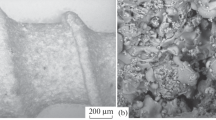Abstract
The objectives of the present work was to evaluate the possibility for fast loading by soaking of bisphosphonates (BPs) into hydroxylapatite (HA) implant coatings biomimetically grown on crystalline TiO2 surfaces, and also investigate the influence of different BP loading concentrations in a buffer during co-precipitation of a calcium phosphate containing layer onto these surfaces. The co-precipitation method created coatings that contained BPs throughout most of the coating layer, but the presence of BPs in the buffer hindered the formation of a bulk HA-layer, thus resulting in very thin coatings most likely consisting of islands built up by a calcium phosphate containing BPs. The coatings biomimetically grown on TiO2 surfaces, were shown to consist of crystalline HA. Soaking of these coatings during 15 min only in a low BPs concentration containing buffer yielded a concentration on the coating surface of the same order of magnitude as obtained with soaking during 60 min in significantly higher concentrated buffers. This could be of advantage during surgery since the operating surgeon could make a fast decision whether or not to include the drugs in the coating based on the need of the particular patient at hand. The BPs present on the surface of the fast-loaded HA coatings were found to be strongly bound, something which should be beneficial for in vivo use. Both the co-precipitation method and the fast loading by soaking method investigated here are promising techniques for loading of BPs onto surgical implants. The simplicity of both methods is an advantage since implants can have spatially complicated structures.







Similar content being viewed by others
References
Francis MD, Valent DJ. Historical perspectives on the clinical development of bisphosphonates in the treatment of bone diseases. J Musculoskelet Neuronal Interact. 2007;7:2–8.
Fleisch H. The role of bisphosphonates in breast cancer: development of bisphosphonates. Breast Cancer Res. 2002;4:30–4. doi:10.1186/bcr414.
Ito M, et al. Ultrastructural and cytochemical studies on cell death of osteoclasts induced by bisphosphonate treatment. Bone. 1999;25:447–52. doi:10.1016/S8756-3282(99)00197-0.
McLeod K, et al. Adsorption of bisphosphonate onto hydroxyapatite using a novel co-precipitation technique for bone growth enhancement. J Biomed Mater Res A. 2006;79A:271–81. doi:10.1002/jbm.a.30792.
Knoch F, et al. Effects of bisphosphonates on proliferation and osteoblast differentiation of human bone marrow stromal cells. Biomaterials. 2005;26:6941–9. doi:10.1016/j.biomaterials.2005.04.059.
Eberhardt C, et al. The bisphosphonate ibandronate accelerates osseointegration of hydroxyapatite-coated cementless implants in an animal model. J Orthop Sci. 2007;12:61–6. doi:10.1007/s00776-006-1081-2.
Peter B, et al. Local delivery of bisphosphonate from coated orthopedic implants increases implants mechanical stability in osteoporotic rats. J Biomed Mater Res A. 2006;76A:133–43. doi:10.1002/jbm.a.30456.
Fleisch H. Bisphosphonates: mechanisms of action. Endocr Rev. 1998;19:80–100. doi:10.1210/er.19.1.80.
Kajiwara H, et al. The bisphosphonate pamidronate on the surface of titanium stimulates bone formation around tibial implants in rats. Biomaterials. 2005;26:581–7. doi:10.1016/j.biomaterials.2004.02.072.
Yoshinari M, et al. Immobilization of bisphosphonates on surface modified titanium. Biomaterials. 2001;22:709–15. doi:10.1016/S0142-9612(00)00234-9.
McLeod K, et al. XPS and bioactivity study of the bisphosphonate pamidronate adsorbed onto plasma sprayed hydroxyapatite coatings. Appl Surf Sci. 2006;253:2644–51. doi:10.1016/j.apsusc.2006.05.031.
Peter B, et al. Calcium phosphate drug delivery system: influence of local zoledronate release on bone implant osteointegration. Bone. 2005;36:52–60. doi:10.1016/j.bone.2004.10.004.
Seshima H, et al. Control of bisphosphonate release using hydroxyapatite granules. J Biomed Mater Res B Appl Biomater. 2006;78B:215–21. doi:10.1002/jbm.b.30446.
Kokubo T, Takadama H. How useful is SBF in predicting in vivo bone bioactivity? Biomaterials. 2006;27:2907–15. doi:10.1016/j.biomaterials.2006.01.017.
Ma J, et al. Biomimetic processing of nanocrystallite bioactive apatite coating on titanium. Nanotechnology. 2003;14:619–23. doi:10.1088/0957-4484/14/6/310.
Stigter M, et al. Incorporation of tobramycin into biomimetic hydroxyapatite coating on titanium. Biomaterials. 2002;23:4143–53. doi:10.1016/S0142-9612(02)00157-6.
Mihranyan A, et al. A study of the specific surface area evolution during biomimetic growth of hydroxyapatite. Langmuir. 2009;25:1292–5. doi:10.1021/la803520k.
Wang X, et al. Apatite deposition on thermally and anodically oxidized titanium surfaces in a simulated body fluid. Biomaterials. 2003;24:4631–7. doi:10.1016/S0142-9612(03)00357-0.
Brohede U, et al. A novel graded bioactive coating on implant for enhanced fixation to bone. Appl Surf Sci. 2009; in press. doi:10.1016/j.apsusc.2009.04.149.
Brohede U, et al. Multifunctional implant coatings providing possibilities for fast antibiotics loading with subsequent slow release. J Mater Sci Mater Med. 2009; in press. doi:10.1007/s10856-009-3749-6.
Yang YZ, et al. Review on calcium phosphate coatings produced using a sputtering process––an alternative to plasma spraying. Biomaterials. 2005;26:327–37. doi:10.1016/j.biomaterials.2004.02.029.
Miller RG, et al. Auger electron spectroscopy of dentin: elemental quantification and the effects of electron and ion bombardment. Dent Mater. 1993;9:280–5. doi:10.1016/0109-5641(93)90075-2.
Frenning G, et al. A new method for characterizing the release of drugs from tablets in low liquid surroundings. J Pharm Sci. 2002;91:776–84. doi:10.1002/jps.10077.
Garcia-Bennett AE, et al. A mechanistic study of the formation of mesoporous structures from in situ ac conductivity measurements. Langmuir. 2007;23:9875–81. doi:10.1021/la700899s.
http://www.eaglabs.com/techniques/analytical_techniques/xps_esca.php. Accessed 12 may 2008.
http://www.probion.fr/xps.php. Accessed 12 may 2008.
Yang Z, et al. Mechanism and kinetics of apatite formation on nanocrystalline TiO2 coatings: a quartz crystal microbalance study. Acta Biomater. 2008;4:560–8. doi:10.1016/j.actbio.2007.10.003.
Ciobanua G, Carjaa G. Structural characterization of hydroxyapatitenext term layer coatings on titanium supports. Surf Coat Tech. 2008;202:2467–70. doi:10.1016/j.surfcoat.2007.11.038.
Sampathkumaran U, et al. Hydroxyapatite coatings on titanium. Adv Eng Mater. 2001;3(6):401–5. doi:10.1002/1527-2648(200106)3:6<401::AID-ADEM401>3.0.CO;2-L.
Mohammadi S, et al. Long-term bone response to titanium implants coated with thin radiofrepuent magnetron-sputtered hydroxyapatite in rabbits. Int J Oral Max Impl. 2004;19:498–509.
Hillner BE, et al. Pamidronate in prevention of bone complications in metastatic breast cancer: a cost-effectiveness analysis. J Clin Oncol. 2000;18:72–9.
Acknowledgement
The author greatly acknowledges The Swedish Governmental Agency for Innovation Systems (VINNOVA) and The Swedish Research Council (VR) for financial support.
Author information
Authors and Affiliations
Corresponding authors
Rights and permissions
About this article
Cite this article
Åberg, J., Brohede, U., Mihranyan, A. et al. Bisphosphonate incorporation in surgical implant coatings by fast loading and co-precipitation at low drug concentrations. J Mater Sci: Mater Med 20, 2053–2061 (2009). https://doi.org/10.1007/s10856-009-3771-8
Received:
Accepted:
Published:
Issue Date:
DOI: https://doi.org/10.1007/s10856-009-3771-8




